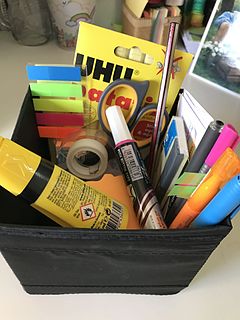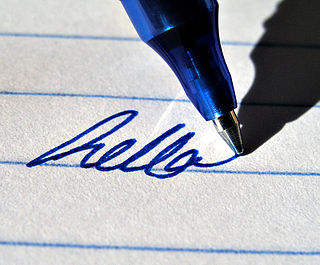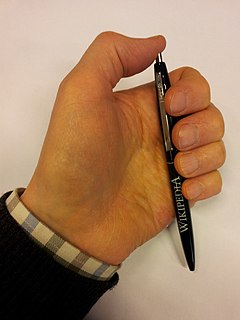Related Research Articles

A ballpoint pen, also known as a biro, ball pen, or dot pen (Nepali) is a pen that dispenses ink over a metal ball at its point, i.e. over a "ball point". The metal commonly used is steel, brass, or tungsten carbide. The design was conceived and developed as a cleaner and more reliable alternative to dip pens and fountain pens, and it is now the world's most-used writing instrument; millions are manufactured and sold daily. It has influenced art and graphic design and spawned an artwork genre.

A plotter is a machine that produces vector graphics drawings. Plotters draw lines on paper using a pen, or in some applications, use a knife to cut a material like vinyl or leather. In the latter case, they are sometimes known as a cutting plotter.

A fountain pen is a writing instrument which uses a metal nib to apply a water-based ink to paper. It is distinguished from earlier dip pens by using an internal reservoir to hold ink, eliminating the need to repeatedly dip the pen in an inkwell during use. The pen draws ink from the reservoir through a feed to the nib and deposits it on paper via a combination of gravity and capillary action. Filling the reservoir with ink may be achieved manually, via the use of an eyedropper or syringe, or via an internal filling mechanism which creates suction or a vacuum to transfer ink directly through the nib into the reservoir. Some pens employ removable reservoirs in the form of pre-filled ink cartridges.

A pen is a common writing instrument that applies ink to a surface, usually paper, for writing or drawing. Early pens such as reed pens, quill pens, dip pens and ruling pens held a small amount of ink on a nib or in a small void or cavity which had to be periodically recharged by dipping the tip of the pen into an inkwell. Today, such pens find only a small number of specialized uses, such as in illustration and calligraphy. Reed pens, quill pens and dip pens, which were used for writing, have been replaced by ballpoint pens, rollerball pens, fountain pens and felt or ceramic tip pens. Ruling pens, which were used for technical drawing and cartography, have been replaced by technical pens such as the Rapidograph. All of these modern pens contain internal ink reservoirs, such that they do not need to be dipped in ink while writing.

Stationery refers to commercially manufactured writing materials, including cut paper, envelopes, writing implements, continuous form paper, and other office supplies. Stationery includes materials to be written on by hand or by equipment such as computer printers.

A stylus is a writing utensil or a small tool for some other form of marking or shaping, for example, in pottery. It can also be a computer accessory that is used to assist in navigating or providing more precision when using touchscreens. It usually refers to a narrow elongated staff, similar to a modern ballpoint pen. Many styluses are heavily curved to be held more easily. Another widely used writing tool is the stylus used by blind users in conjunction with the slate for punching out the dots in Braille.

A dip pen or nib pen or pen nib usually consists of a metal nib with capillary channels like those of fountain pen nibs, mounted in a handle or holder, often made of wood. Other materials can be used for the holder, including bone, metal and plastic; some pens are made entirely of glass.

Nondestructive testing (NDT) is any of a wide group of analysis techniques used in science and technology industry to evaluate the properties of a material, component or system without causing damage. The terms nondestructive examination (NDE), nondestructive inspection (NDI), and nondestructive evaluation (NDE) are also commonly used to describe this technology. Because NDT does not permanently alter the article being inspected, it is a highly valuable technique that can save both money and time in product evaluation, troubleshooting, and research. The six most frequently used NDT methods are eddy-current, magnetic-particle, liquid penetrant, radiographic, ultrasonic, and visual testing. NDT is commonly used in forensic engineering, mechanical engineering, petroleum engineering, electrical engineering, civil engineering, systems engineering, aeronautical engineering, medicine, and art. Innovations in the field of nondestructive testing have had a profound impact on medical imaging, including on echocardiography, medical ultrasonography, and digital radiography.

In forensic science, questioned document examination (QDE) is the examination of documents potentially disputed in a court of law. Its primary purpose is to provide evidence about a suspicious or questionable document using scientific processes and methods. Evidence might include alterations, the chain of possession, damage to the document, forgery, origin, authenticity, or other questions that come up when a document is challenged in court.
A writing implement or writing instrument is an object used to produce writing. Writing consists of different figures, lines, and or forms. Most of these items can be also used for other functions such as painting, drawing and technical drawing, but writing instruments generally have the ordinary requirement to create a smooth, controllable line.

Metallography is the study of the physical structure and components of metals, by using microscopy.

Roller ball pens or roll pens are pens which use ball point writing mechanisms with water-based liquid or gelled ink, as opposed to the oil-based viscous inks found in ballpoint pens. These less viscous inks, which tend to saturate more deeply and more widely into paper than other types of ink, give roller ball pens their distinctive writing qualities. The writing point is a tiny ball, usually 0.5 or 0.7 mm in diameter, that transfers the ink from the reservoir onto the paper as the pen moves.

Rotring is a former German manufacturing company of technical drawing tools and writing implements. Established in 1928 as a fountain pen manufacturer, Rotring is currently a brand owned by Newell Brands after its acquisition in 1998. The name "Rotring" directly translates to "red ring" which is still placed around the barrel of their pens today. The company's name was changed to Rotring in the early 1970s to match the trademark.

A gel pen uses ink in which pigment is suspended in a water-based gel. Because the ink is thick and opaque, it shows up more clearly on slick surfaces than the typical inks used in ballpoint or felt tip pens. Gel pens can be used for many types of writing and illustration.
An electrostatic detection device, EDD or ESDA, is a specialized piece of equipment commonly used in questioned document examination to reveal indentations or impressions in paper that may otherwise go unnoticed. It is a non-destructive technique, allowing further tests to be carried out. It is a sensitive technique capable of detecting indentations on pages several layers below the top sheet and many years after the indentations were created.

Zebra Co., Ltd. is a Japanese manufacturer of writing instruments, established in 1914 by Tokumatsu Ishikawa.

The American Board of Forensic Document Examiners, Inc. (ABFDE) is a non-profit organization which provides third-party certification of professional forensic document examiners (FDEs) from Canada, Australia, New Zealand, and the United States of America, and other countries places if approved by the Board of Directors. Sponsored by the American Academy of Forensic Sciences at its inception in 1977, the ABFDE is the largest certifying body of forensic document examiners in North America. Individuals holding a valid Certificate of Qualification issued by the ABFDE use the designation "Diplomate of the American Board of Forensic Document Examiners", often abbreviated as D-ABFDE.
Signature forgery refers to the act of falsely replicating another person's signature.

Retractable pens are a type of ink pen which have a spring-loaded ink cartridge which retracts and extends outside a protective housing. By clicking downward on the top of the pen, the tip is extended and locks in place at the bottom of the housing for use.

The International Ink Library and its Digital Ink Library are an FBI forensic database of inks. It is used to identify writing instruments, makes, models, ink types, and document authenticity. It contains over 15,000 samples of pen, marker, and printer inks dating from the 1920s. As part of the FBI Questioned Documents Branch, it is used to investigate criminal and terrorist cases, fraudulent documents, forgeries, checks, money orders, and threats to persons. It uses high-performance thin-layer chromatography, electrophoresis, ultraviolet spectra, electrospray ionization and mass spectrometry. It also analyzes chemical date tags expressly inserted by ink manufacturers. The database originated in the 1960s from the collection of Antonio Cantu, former Chief Forensic Chemist at the Secret Service, which dedicated the lab in his honor.
References
- ↑ ASTM Standard E444-09 (Standard Guide for Scope of Work of Forensic Document Examiners) indicates in section 4.2.1.4 that the work of a forensic document examiner includes "The establishment of the date, source, history, sequence of preparation, alterations or additions to documents, and relationships of documents". Copies of ASTM Standards can be obtained directly from ASTM International.
- ↑ Igoe, T.J.; Reynolds, B.L. (1982), A lifting process for determining writing sequence of two intersecting ball-point pen strokes, vol. 20, Forensic Sci Int, p. 201
- ↑ Binette, Julie; Barton, Andrew; Ostrum, R. Brent (2019), Sequence determination between blue ballpoint pens and toner using Mikrosil™ casting of the intersection, vol. 52, CSFS Journal, doi:10.1080/00085030.2019.1682217
- ↑ "Indented impressions". LGC Limited. Archived from the original (HTML) on 2011-07-13. Retrieved 2019-02-19.
In more complex cases the order that writing and indentations were made may be deduced providing significant information regarding a sequence of events.